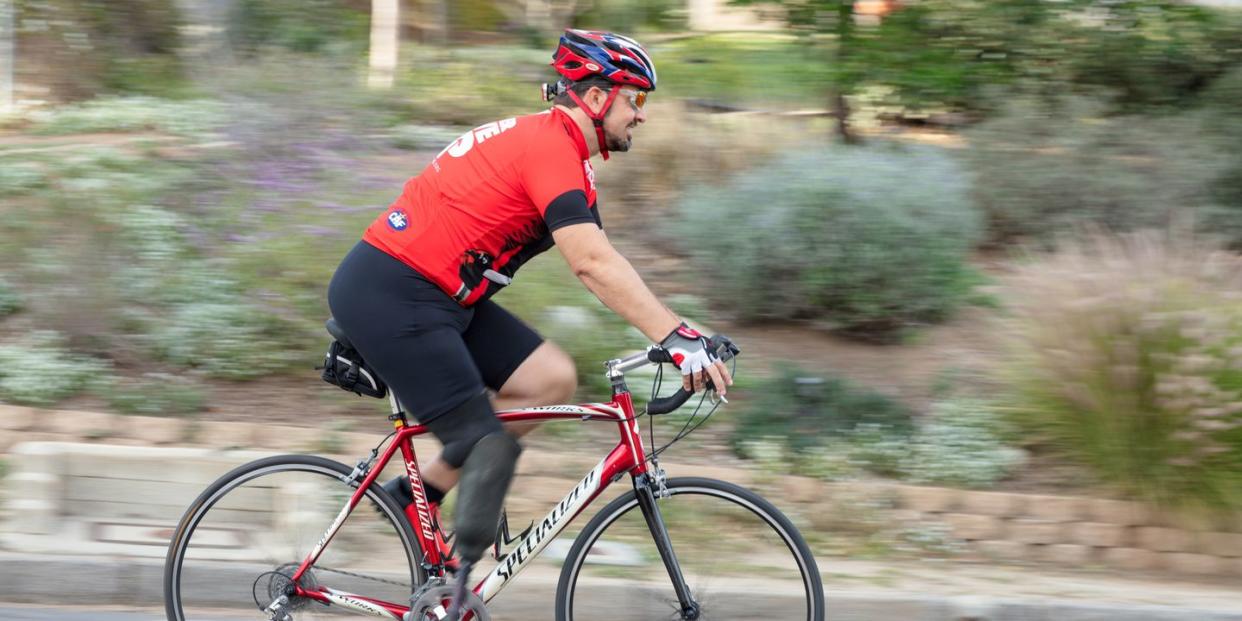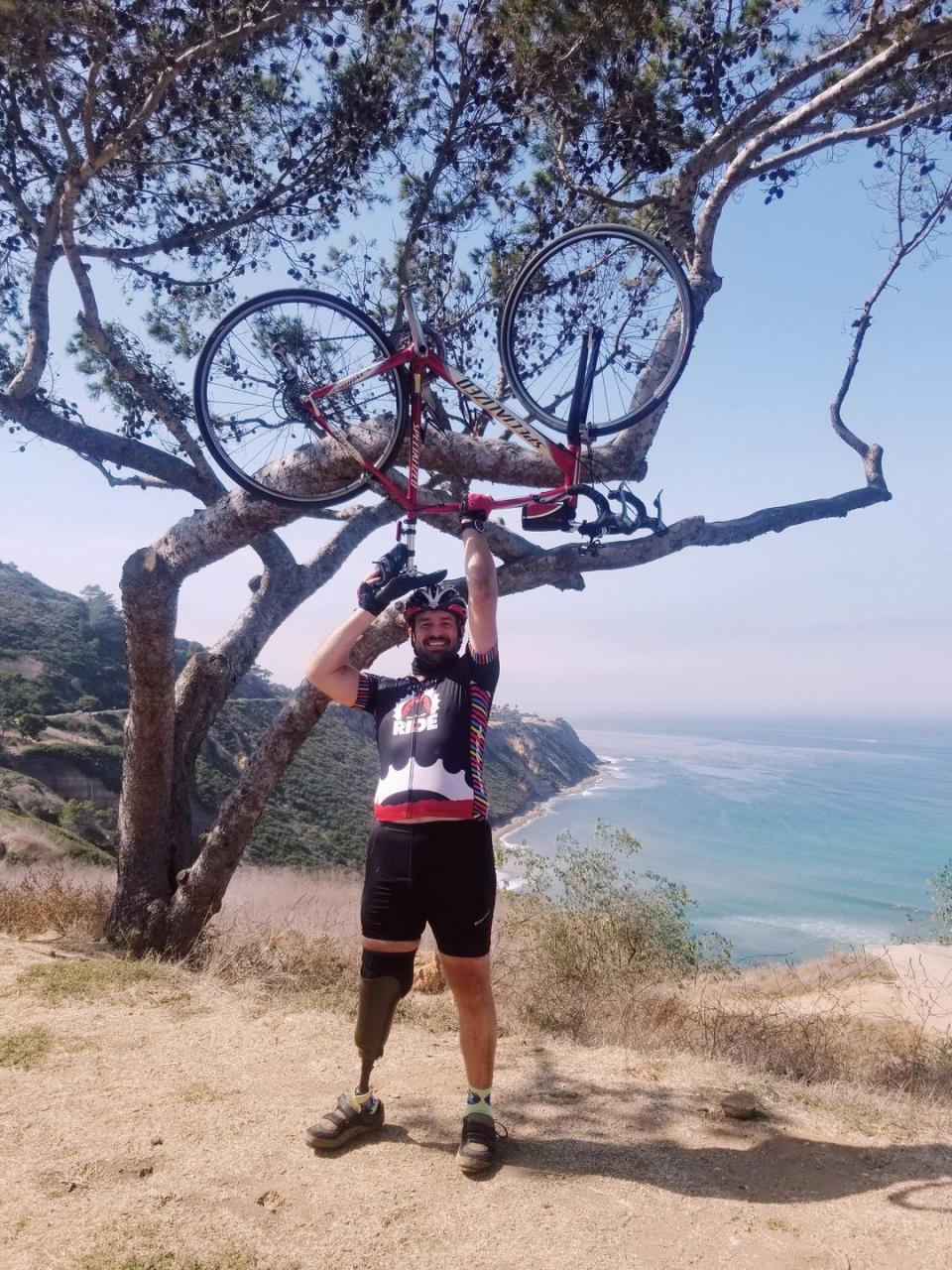After Losing His Leg in an Accident, This Cyclist Dedicates His Work to Making Streets Safer

Name: Damian Kevitt
Age: 45
Hometown: Los Angeles, California
Occupation: Executive director, Streets Are For Everyone
Time Cycling: 28 years
Reason for Cycling: I ride for enjoyment, to get around (especially when it’s easier than by car) and for my health. Cycling is my form of meditation—me, my body, and the environment around me working as one.
I grew up cycling. My parents used to take me on mini cycling tours as a kid, riding 20 to 30 miles as a family. Dad was in the front, I was in the middle, and my Mom rode behind me. Sometimes we’d pack the our bike panniers and cycle down the coast of Southern California, staying the night at hotels. I loved it. (The only issue: The helmets back then were awful. I looked like an alien.)
As I got older, cycling became the way I got around and helped me be independent. Even after I got a car when I was 17, I would still ride around. Cycling was both enjoyable and a mode of transportation. Later, I got a nifty Cateye computer for my bicycle (it was so cool!) to track my miles and speed, but that’s about all that it did.
I never did a race or a challenge until after I was hit and nearly killed while riding a bicycle in February 2013. I was cycling with my wife in Griffith Park, going on a picnic to the Los Angeles Zoo. Only a few hundred feet from my destination I was hit, pinned underneath a car, and dragged underneath nearly a quarter mile from the streets, onto and down Interstate 5 at freeway speeds. My right leg was ripped off and about 20 pounds of flesh in two minutes. Miraculously, I survived. (I now wear a prosthetic.) It was a hit and run. The driver never stopped and was never caught.
How I survived and my struggles in the hospital and afterwards is worth its own article—but what I can say is that eventually, I got back on my bicycle and started to teach myself how to ride again.
During my time in the hospital, I learned about how deadly the streets of Los Angeles are—not just for cyclists, but everyone including pedestrians, kids, the elderly, drivers, and motorcyclists. More importantly, I found out that L.A. is the hit and run capital of the U.S. An estimated 48% of all collisions in L.A. are hit and runs.
I had a story, and I was alive to tell it. There are hundreds of others in Los Angeles every year who will never be able to tell their story because they became a statistic. So, I launched a cycling event called Finish The Ride to tackle the epidemic of hit and runs in Los Angeles. That event and the actions before and after it helped to drop hit and run crimes by 16% in a single year.
More importantly, that event became my organization Streets Are For Everyone (SAFE), a non-profit with the mission of making streets safer for all road users. We have a free support service for victims of traffic violence, and I’m proud of every person we touch who is thankful for our help.
Our Finish The Ride event happens every year (now twice a year)—in Griffith Park in spring and in Santa Clarita around Halloween. Last year, despite the pandemic we had almost 1,600 participants. It was epic!
There are a number of pieces of legislation that we have sponsored or supported that have made streets safer for cyclists and others as well. You would think legislators would automatically support legislation to save lives, but it’s not always so easy. Right now, we are working heavily on a campaign to make Griffith Park safer, and I’m very proud of the work accomplished. (Please check out our petition on it.)
We also have a film competition for high school students to make traffic safety PSAs, mentored by Hollywood filmmakers. That’s grown from one school and a few students to several dozen schools and hundreds of students all across Southern California.
Finally, one of our bigger accomplishments is the redesign of La Tuna Canyon Road—a road heavily traveled by cyclists, but also not a safe road. This was something that the community around La Tuna Canyon had been wanting to accomplish for 40+ years. A family came to us for help after their father was hit and nearly killed while cycling on it. SAFE took it on and got the community to support a major redesign that was accomplished in only six months—lightening speed for the city of Los Angeles.
What keeps me motivated to keep cycling is just wanting to ride, to feel my heart racing, my legs pumping, the wind on my skin and blowing through my hair, and looking around at things that 99% of people miss when driving in a car.
If I go to the office, I often commute by bicycle or try to do some of my errands on my bike. (Honestly, with gas prices in California, it’s a necessity.) On the weekend, I try to do a longer ride, between 40 and 80 miles. Sometimes, I’ll sneak in a more than 20-mile ride mid-week. More recently, I’ve started to jog again. Also, I’m dipping my toes into the idea of doing a triathlon.
Life is a tough game for most people. Sometimes you’ve got to disengage and do something totally different, force yourself to take your mind off the bills, the chronic bad news, the politics, and the setbacks. Cycling is my way to do that. Not everyone feels that way about cycling but everyone needs to have an activity, an outlet, to feel that way about.
If I had any advice to tell others, it would be around safety. Cycling is wonderful, but you always have to assume that the cars around you don’t have any idea you’re there. They will do some of the craziest things, thinking it’s safe to do so. Most (not all) drivers are not ill-intentioned, but most drivers are not fully aware of what’s happening around them. A cyclist has to always cycle with a defensive viewpoint because in a fight between a car and a cyclist, guess who will always lose? The cyclist.
It might be odd for some when I say this, but cycling nearly killed me, and at the same time, it brought me life. More importantly, I’ve been able to save others lives as a result of what the team at Streets Are For Everyone does.

These three tips made my cycling journey a success:
1. Do what you’re comfortable doing
Not every type of cycling is right for everyone. Touring, racing, mountain biking, commuting, family rides, etc.—pick what you want to do and enjoy it! Understanding this has been even more important for me as I’ve dealt with challenges of cycling after losing my right leg.
2. When riding in traffic, always assume others don’t see you
You can be 100% in the right about your actions, but if you incorrectly assume cars, trucks, any automobile sees you and they don’t, you’ll always end up on the losing side of the equation. I can’t tell you how many times I’ve avoided potentially disastrous consequences by being willing to slow down a bit and wait to make sure the person in front or beside me actually sees me.
3. Ride with others when you can
This is for safety purposes, but also riding with someone else can help push you to go faster or farther than you might do by yourself.
Damian’s Must-Have Gear
→Custom Finish The Ride Jersey: You don’t have to look cool to be a good cyclist, but it helps. That’s why I like high-quality jerseys that support Streets Are For Everyone. I never ride without one.
→Specialized S-Works Tarmac Performance Road Bike: I have an old 2014 frame and love it to pieces. (Don’t worry, it’s still in one piece.) It’s rugged, smooth, and super light.
→ Specialized Comp Mountain Bike Shoes: Due to my prosthetic leg, these are one of the only cycling shoes I can wear. Plus, they look cool as well.
→ Cycliq Bicycle Lights: These are nice and bright and have a camera embedded in the rear and front lights, which gives me extra peace of mind when battling cars on the roads of a big city.
We want to hear how cycling changed you! Send your story and submit your photos to us via this web form. We’ll pick one each week to highlight on the site.
You Might Also Like

